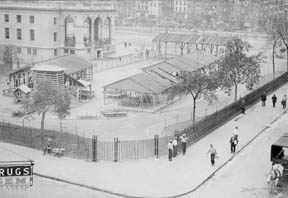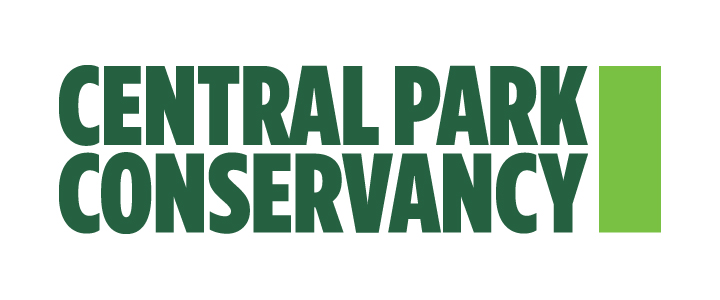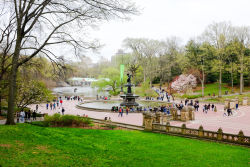Central Park
The Daily Plant : Thursday, October 16, 2003
ONE HUNDRED YEARS OF PLAYGROUNDS

Today, playgrounds are a staple of childhood, and can be found at almost every school and park, but one hundred years ago, play areas for children were rare, and the term “playground” was used to describe anything from a football field to a pile of sand in a parking lot. Today, as we celebrate the one-hundredth birthday of New York City’s first municipal playground, Seward Park, The Daily Plant will take a quick tour of one hundred years of playgrounds in New York.
The birth of playgrounds officially began in 1887 with The Small Parks Act, which allowed for the purchase of small open spaces for children’s playgrounds. However, the idea of public playgrounds didn’t really get off the ground until 1898, when Charles B. Stover and Lillian D. Wald of the Settlement House, formed the Outdoor Recreation League (ORL). The ORL sponsored privately funded playgrounds on parkland, and created some of the first organized recreational activities for children. Until the creation of ORL, the only public playgrounds were provided by the Board of Education. In 1902, Mayor Seth Low arranged to have the Parks Department work in conjunction with ORL to operate and improve playgrounds. Their first project was the creation of Seward Park, New York City’s first municipally built playground.
When it opened in 1903, Seward Park heralded a new era in children’s playgrounds in the city, becoming a model for playground programming and design. The facility in the north corner of the park featured cinder surfacing, fences, a recreation pavilion, as well as play and gymnastic equipment. In addition to the playground, the 1903 plan featured a large running track with an open play area in the center and a children’s farm garden in the southeast corner. Curving paths and a north-south mall divided the park into recreational areas. The limestone and terra cotta Seward Park Pavilion was equipped with marble baths, a gymnasium, and meeting rooms. Rocking chairs were placed on the broad porch for the use of mothers tending their small children.
Parks and playgrounds soon became an important political issue and in 1910, Parks & Recreation Commissioner Charles Stover began a campaign to increase the number of playgrounds in the city began in earnest. In the same year, the City created the post of Supervisor of Recreation in order to focus resources in the area of children’s recreation. The creation of the post was supported by playground associations as well as the National Highway Protective Society, whose mission was to keep children from playing in the streets. While new playgrounds were still in development, interim playgrounds were opened, all over the city. Undeveloped city lots were used for play areas, school yards were opened year-round, and elevated play areas were constructed on the city’s bridges and piers.
Although playgrounds today offer amenities for all ages, it was not always this way, and girls and boys were often separated, according to Parks Annual Reports from the turn of the century. Athletic and baseball fields, for example, were designed for young men and boys over 14—girls need not participate! Girls in fact had their own playgrounds, but it is interesting to note that boys under eight were welcome there, too. Girls' and boys' playgrounds contained similar equipment but girls' playgrounds provided more space for "free games" and included sandboxes and baby hammocks for the "very small children.” Finally, Parks officials also provided "midget playgrounds" for children under four which included sand piles, small swings and hammocks.
As the idea of playgrounds began to catch on, their numbers increased steadily. By 1913, there were 46 Parks & Recreation playgrounds. By 1915, there were 70 equipped playgrounds throughout the city. By the 1920s playgrounds had become an essential piece of parks systems across the country. When Robert Moses took over as Parks Commissioner in 1934 there were 119 playgrounds and by the end of his tenure, in 1960, there were 777. The rapid growth of playground facilities in the city was helped by massive federal spending during the Depression through the Works Progress Association.
Over the years, there have been trends in playground design. In the 1950s playgrounds with interactive concrete shapes were all the rage. “Adventure playgrounds” debuted in the 1960s and 1970s as a way to tap in to children’s imaginations. (Architect Richard Dattner designed several such playgrounds in Central Park.) Playground safety also became an important issue in the 1970s, and many playgrounds were retrofitted to eliminate hazardous conditions such as hard surfaces and the potential for long falls. In the 1980s and 1990s, playgrounds were designed to reflect the culture and history of the neighborhoods they occupied, or the include elements that bore some relationship to the name of the playground. Today, Parks & Recreation maintains over 950 playgrounds and are the stewards of countless childhood memories.
QUOTATION OF THE DAY
“My heart is a lonely hunter that hunts on a lonely hill.”
William Sharp
(1855-1905)
Check out your park's Vital Signs
Clean & Safe
Green & Resilient
Empowered & Engaged Users
Share your feedback or learn more about how this park is part of a
Vital Park System

Know Before You Go
Anticipated Completion: Spring 2024
Anticipated Completion: Spring 2025

Contacts
Central Park Information: (212) 310-6600
Central Park Information (for the Hearing Impaired): (800) 281-5722
Belvedere Castle, The Henry Luce Nature Observatory: (212) 772-0210
The Charles A. Dana Discovery Center: (212) 860-1370
The Dairy Visitor Center and Gift Shop: (212) 794-6564
North Meadow Recreation Center: (212) 348-4867
Loeb Boathouse (Bike rentals, boat rentals & gondolas): (212) 517-2233
Carousel: (212) 879-0244
Fishing at Harlem Meer (Catch & Release): (212) 860-1370
Harlem Meer Performance Festival: (212) 860-1370
Horseback Riding - Claremont Stables: (212) 724-5100
Metropolitan Opera (Performances on the Great Lawn): (212) 362-6000
New York Philharmonic (Performances on the Great Lawn): (212) 875-5709
Shakespeare in the Park - The Public Theater at the Delacorte Theater: (212) 539-8655
Central Park SummerStage: (212) 360-2777
Swedish Cottage Marionette Theater: (212) 988-9093
Tennis: (212) 280-0205
Weddings, Ceremonies and Photography at the Conservatory Garden: (212) 360-2766
Wildlife Center & Tisch Children's Zoo: (212) 439-6500











